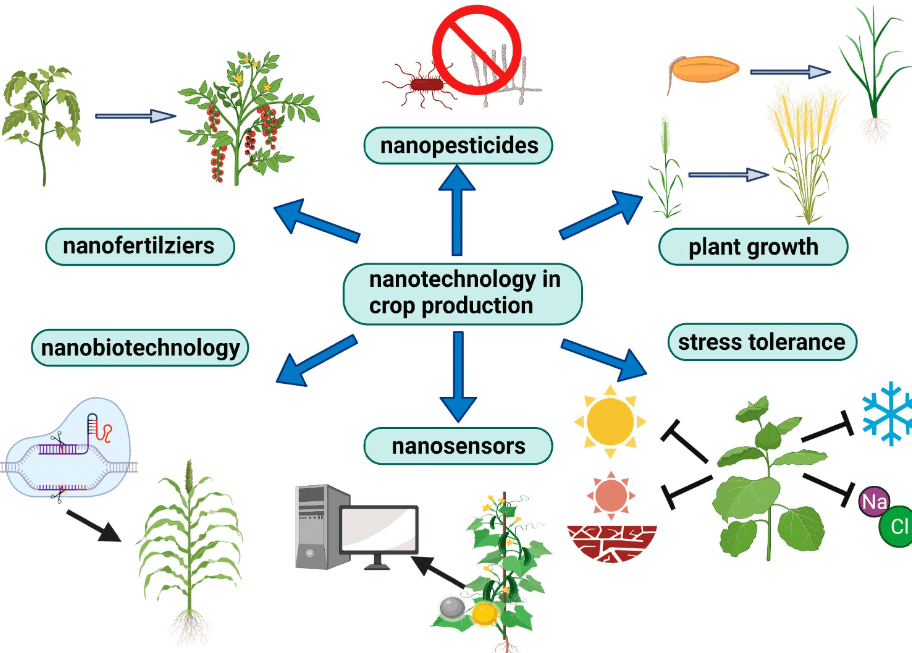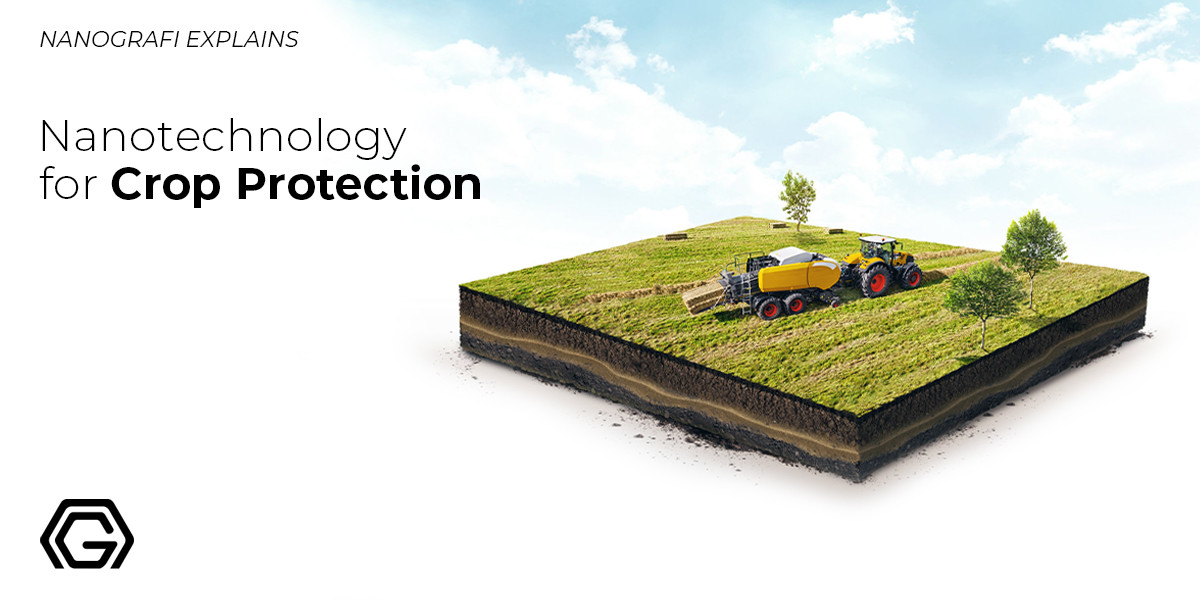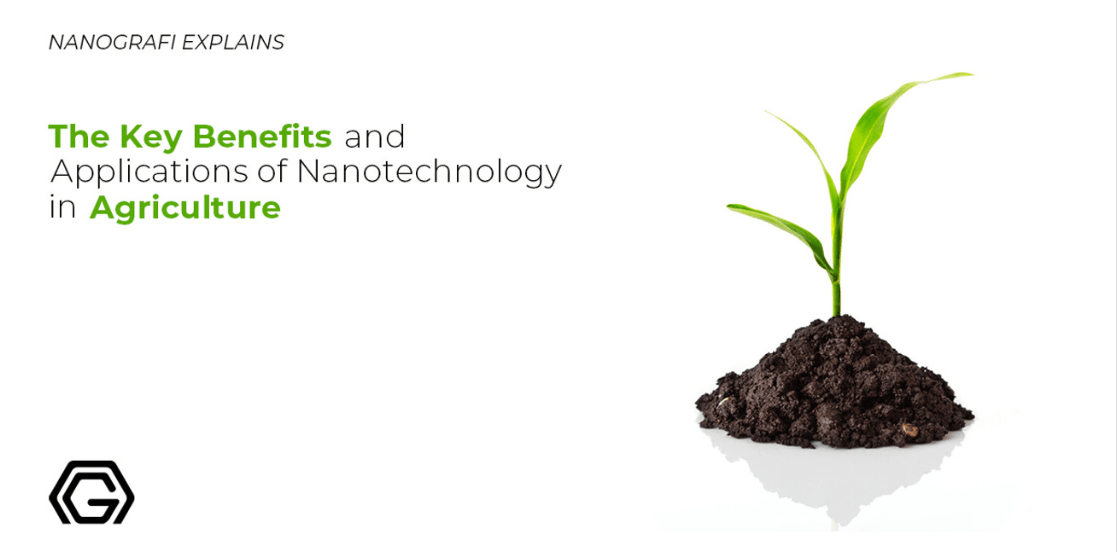Nanotechnology for Crop Protection
Crop protection is an important part of agricultural activities. Further development in crop protection methods is required to meet increasing food production demand and overcoming the negative effects of climate change.
Nanotechnology offers promising solutions to these problems through the development of effective and selective nanopesticides. Working with more than 100 countries and numerous universities, we, Nanografi, are striving to develop these solutions day by day.
Introduction
The combined effect of increasing human population and climate change has raised concerns about food production and supply. The Food and Agricultural Organization of the United Nations (FAO) has published a report that supports the concerns on world food production. According to this report, the predicted 9.1 billion world population by 2050 will require a 70% rise in food production. Such an increase in food production faces several challenges such as energy prices, urbanization, drought, a decrease in soil quality, etc. Additionally, production yields should be improved to achieve sufficient food production. One of the important strategies to obtain high crop yield is improving crop protection methods. Crop protection is a wide area of practice that includes tools, products, and practices farmers use to defend their crops against weeds, disease, and harmful insects and fungi. Each year, these undesired conditions cause substantial loss of production and decrease crop yield. Several different systems and products are used to avoid these damages. However, innovative solutions and improved efficiencies are required to obtain better results in crop protection. For this purpose, scientists have recently been resorting to nanotechnology. The desirable characteristics of nanotechnology are utilized to improve herbicides, fungicides, bactericides, and insecticides on weed and phytopathogens. The advantages of nanosized systems include enhanced bioavailability, targeted delivery, controlled release, protection against degradation, and higher potency.
What is the Role of Nanotechnology in Crop Production?
Nanotechnology is used to develop effective nanopesticides including nanoherbicides, nanofungicides, nanobactericides, and nanoinsecticides. Modern agriculture resorts to nanoherbicides for effective inhibition of unwanted vegetation. Nanosized formulations of current herbicides and new nanoherbicides formulations both focus on the effective delivery of the material and selective application. The potential selectivity of nanoherbicides can provide inhibition of specific weeds without damaging valuable vegetation. This approach provides safer herbicides for both the human race and the environment. Different metallic active ingredients and polymeric nano systems are used for the development of nanoherbicides.
A considerable portion of diverse fungi species can cause harm to plants and result in decreased crop yields. Although it is not limited to this list and contains over 250,000 fungi species, some of the well-known harmful fungi species for food production can be listed as Botrytis, Sclerotinia, Aspergillus, Fusarium, and Verticillium. Hence, developing nanofungicides that target specific fungus species is important for crop protection. Similarly, over 15,000 species of bacteria are considered to be harmful to plants and cause production losses worldwide. Harmful bacteria species include Erwinia, Acidovorax, Pseudomonas, Ralstonia, Rhizobacter, Xanthomonas, Agrobacterium, Xylella, Arthrobacter, Clavibacter, and Streptomyces. Nanobactericides that target hazardous bacteria can help to obtain better crop protection. Both inorganic and inorganic nanomaterials and nano systems are utilized for the development of nanobactericides and nanofungicides.
Insects are another type of notorious problem in agriculture. Almost every plant is vulnerable to different types of insects that destroy the crop, infest the product, and cause a serious decrease in production yield. Hence, insecticides hold an important place in agriculture. Incorporating nanotechnological solutions to insecticides can provide an effective and selective process as well as environmental protection. Organic or inorganic nanopesticides can be applied against insect eggs, larvae, or adult insects.
To learn the key benefits and applications of nanotechnology in agriculture, read blog.
Nano Systems and Nanomaterials for Crop Protection
Nanotechnology is used for the encapsulation of nanopesticides or to develop active nanomaterials. Polymer based nano systems can be utilized as encapsulating materials while nanosized nanomaterials are utilized as active ingredients in nanopesticides. Encapsulating nano systems can consist of both synthetic and organic polymers. The most common polymer nano systems for crop protection are nanocapsules, nanospheres, nanogels, and micelles. The solid or liquid core of nanocapsules consists of active nanopesticides particles while a polymeric shell encapsulates and forms the outer layer. Nanocapsules are produced through different methods the active ingredients are then loaded into the polymeric capsule. Nanospheres are similar structures to nanocapsules; however, the material polymerizes along with the active ingredient and captures nanopesticides during formation. Micelles are specifically used to deliver water insoluble nanopesticides. For this purpose, amphiphilic block copolymers are utilized. The hydrophilic copolymer faces outwards while the hydrophobic copolymer faces inwards encapsulating the nanopesticides material. Nanogels are formed through the cross linking of hydrophilic polymers. These structures can swallow and take up a considerable amount of nanopesticide materials providing an effective delivery method.
Similar to polymeric materials, lipid-based structures such as nanoliposomes and solid lipid nanoparticles are also utilized for the effective delivery of nanopesticides. Active materials can be trapped in these structures. Nanoliposomes are made up of a lipid bilayer shell and an aqueous core containing active ingredients while solid lipid nanoparticles capture nanopesticides through recrystallization. Porous nanoparticles such as silica nanoparticles and nanoclays also provide a suitable environment for nanopesticide loading. These nanoparticles are advantageous due to their environment friendly nature and abundance. Functionalized porous silica nanoparticles can be absorbed in the insect cuticular membrane lipids, damaging their protective waxy layer and causing dehydration. Furthermore, the porous nature of silica and clay nanoparticles allows the slow and controlled release of active ingredients.
Metallic, nonmetallic nanoparticles and their composites can be utilized as active nanopesticide materials. These nanoparticles show unique physical, chemical, optical, and biological properties along with improved activity due to their high surface area. The most common metallic nanoparticles in crop protection are silver, silver oxide, gold, zinc oxide (ZnO), titanium oxide, magnesium oxide, and copper oxide. Silver nanoparticles are effective against bacteria and spore-forming fungi; however, they are nontoxic to animals which make them promising candidates as nanopesticides. ZnO nanoparticles act as nanobactericides due to their phototoxicity and electrostatic interaction with the bacterial cell surface. Another well-known nanoparticle for its antibacterial property is TiO2. Titanium dioxide nanoparticles are effective nanobactericides since they cause site-specific damage in DNA and proteins of the pathogen. Similarly, Cu nanoparticles, MgO nanoparticles, and Silica nanoparticles show antibacterial properties and are used as nanobactericides materials. Apart from metallic NPs, other materials such as silica-based, C-based, sulfur-based, and aluminum-based NPs are also used in crop protection. In addition to utilizing nanosystems and nanoparticles separately in crop protection, the composite structures of these materials are also utilized as nanopesticides. Ceramic matrix composites, metal matrix composites, and polymer matrix composites can provide brilliant effective nanopesticide systems. Carbon nanotubes are found to be excellent carriers and active materials in nanopesticides.
All of these nano scale solutions are currently being investigated and utilized in enhanced agricultural applications for crop production in the hopes of improving production yields.

Figure 1. The applications of nanotechnology in crop production.
Conclusion
The rapid growth of the human population has increased the demand for agricultural production, while agriculture faces challenges from climate change, urbanization, and decreased soil quality. Novel approaches are necessary to meet these increasing demands. Crop protection is crucial in this context, as it deals with weeds, disease, and harmful insects and fungi, which significantly decrease plant yields. Traditional crop protection methods have been found to be ineffective and wasteful, leading scientists to turn to nanotechnology for more effective solutions.
This has resulted in the development of nanoherbicides, nanofungicides, nanobactericides, and nanoinsecticides. Nanotechnology employs nano systems for the delivery of nanopesticides and as active ingredients. Common delivery systems include polymer-based nanostructures like nanocapsules, nanospheres, nanogels, and micelles, as well as lipid-based structures such as nanoliposomes and solid lipid nanoparticles. These systems encapsulate active ingredients for targeted nanopesticide release. Additionally, porous silica and clay nanoparticles are used as carriers. Active nanomaterials in crop protection include metallic nanoparticles like silver, silver oxide, gold, zinc oxide (ZnO), titanium oxide, magnesium oxide, and copper oxide, as well as non-metallic nanoparticles such as silica-based, carbon-based, sulfur-based, and aluminum-based types. These nanotechnologies offer effective and selective crop protection methods and are open to further improvement.
To learn about current blogs about nanotechnology and advanced nanomaterials, you can visit Blografi.
References
Jampílek, J., & Kráľová, K. (2018). Benefits and potential risks of nanotechnology applications in crop protection. In Nanobiotechnology Applications in Plant Protection (pp. 189-246). Springer, Cham.
Liu, C., Zhou, H., Zhou, J., Liu, C. ;, Zhou, H. ;, & Zhou, J. (2021). The Applications of Nanotechnology in Crop Production. Molecules 2021, Vol. 26, Page 7070, 26(23), 7070. https://doi.org/10.3390/MOLECULES26237070
Ojha, S., Singh, D., Sett, A., Chetia, H., Kabiraj, D., & Bora, U. (2018). Nanotechnology in crop protection. In Nanomaterials in Plants, Algae, and Microorganisms (pp. 345-391). Academic Press.
Shang, Y., Hasan, M., Ahammed, G. J., Li, M., Yin, H., & Zhou, J. (2019). Applications of nanotechnology in plant growth and crop protection: a review. Molecules, 24(14), 2558.
The Key Benefits and Applications of Nanotechnology in Agriculture - Nanografi Nano Technology. (n.d.). Retrieved December 22, 2023, from https://nanografi.com/blog/the-key-benefits-and-applications-of-nanotechnology-in-agriculture/
2050 High-Level Experts Forum: The Forum. (n.d.). Retrieved December 22, 2023, from https://www.fao.org/wsfs/forum2050/wsfs-forum/en/
Recent Posts
-
MXenes from MAX Phases
MXenes, a group of two-dimensional materials derived from MAX phases, are gaining significant tracti …19th Oct 2024 -
Preserving History with Graphene's Power
Cultural artifacts are at risk of deterioration over time due to the destructive effects of both na …11th Oct 2024 -
The Role of Graphene in Neuroelectronics
Neuroelectronics is an interdisciplinary field that aims to develop devices that can interact with t …4th Oct 2024






